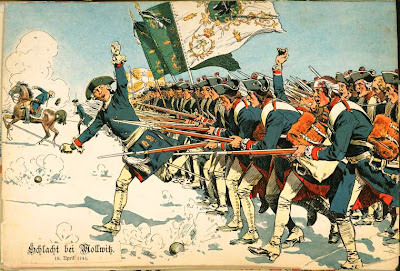The game is a follow on to the (in my opinion) very well done Hold the Line, which was a sequence of battles from the American War for Independence. That game also had an add-on module, covering the French and Indian War.
The game has very attractive counters, a very functional map (with multiple terrain tiles so you can reset for any of the different scenario maps), a great full color rulebook, and a couple of dice.
My only comment on the components is that I really preferred the wider infantry unit markers from the original Hold the Line. It made them feel like battalions in line formation. But, as the scale of the battles represented in Frederick's War is so great, that each marker is representing much more than a battalion (or even a regiment), it probably doesn't matter.
I was an early (pre-production) backer of this, and I have to say that Worthington did a very good job in getting it out.
The rulebook is great (one minor flub, and might be my own error), and covers a number of key Seven Years War (and the earlier War of the Austrian Succession) scenarios that were pivotal for Prussian (and Frederick II himself). If this title is successful, I could easily see additional add-on modules featuring other armies and more scenarios from this time period (or even stretching it back to the early 18th century - I would be first in line, for instance, for a "Hold the Line: Peter The Great" module featuring Swedish and Russian armies and scenarios from the Great Northern War).
A promo picture is circulating (still) on Boardgame Geek and other places that features a shot of some units on a board, and it features some British units - units that only appear in the Highland Charge module. Not a big deal, but hopefully it isn't too misleading for folks. On Board Game Geek, Sean Chick (designer) himself comments that it was a mistake so show them in the image.
I am looking forward to a solo play of this game, and I will post an AAR of it.
Oh - the minor flub in the rulebook that I mentioned - I couldn't find in the text that in combat, units all roll 3d6 in all situations (except fire combat at long range, where it is reduced to 1d6). It is mentioned on the quick reference chart for combat, but not in the rules text. There, the number of dice in combat is only mentioned as "fire combat dice" on a fire combat table, but there are at least two other types of combat, so by making the mention explicitly for fire combat, it threw me when I was trying to see how many dice are rolled for close combat (for infantry) and for charges (for cavalry). Minor point, and it was cleared up in the examples, and by the line on the QR chart, but still - what is a review without pointing out one wart in an otherwise very compelling looking game??
Conceptually - the game and the scenarios look great. I do have a minor quibble there - but in the end, my complaint will probably be a recognized strength of the game. Here it is - considering the size of the armies that encountered each other in these battles, the number of maneuver elements in the game seems surprisingly low. The battles in the American War of Independence are quite small in comparison, and many of them feature more maneuver elements than the battles here (please forgive: this is only my opinion, and only after an initial un-boxing and read-through of the rules and scenario). With the original game in my mind, these battles seem more like skirmishes than the epic 18th century struggles that they were... I will report back after playing a battle or two.
 |
| Great image of Frederick leading the way at Mollwitz (could have been cover art) |
Here is an image from BGG showing the setup for the battle of Mollwitz (April 10, 1741; Prussian v. Austria; The War of Austrian Succession) the image was originally posted by Scott Smith:
The Austrians (white markers) are set up in (roughly) one line, and the Prussians (blue markers) are set up in two dispersed lines (three infantry each) with some artillery out front, and some outlying flankers. This battle was fought between 22,000 on the Prussian side vs. 23,000 on the Austrian side. Here is a nice reconstruction map:
Also, definitely check out the web page of Mike Bishop - he has a great map of the battle there as well.
So, with armies of around 20,000 (my exact numbers could be off, I have seen totals for the Prussians ranging from 16,000 to 22,000, depending on what you count, and who is doing the counting), it just feels a little more like a skirmish encounter than a large battle to have around a dozen counters.
Here is an example from the first game - the battle of Bemis Heights (day two of the Battle of Sarratoga). This battle featured 8,000 Rebels against 5,000 British. Here is a picture of the game setup.
As I mentioned, I believe once I play the game, the number of counters will feel "right", and the discrepancy of scale between battles shouldn't matter (it is the game that matters, after all). It is just a thought that occurred to me as I looked at the battles. I won't go into the battle of Hochkirch (which is also a scenario in Frederick's War) featuring 35,000 Prussians v. 80,000 Austrians... I will hold my breath until I play the game (which I am sure will play very enjoyably).













